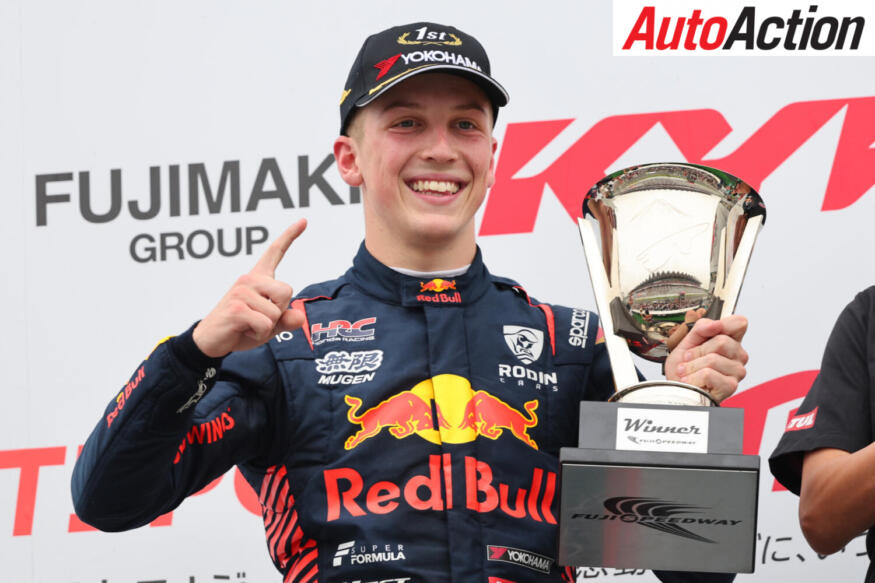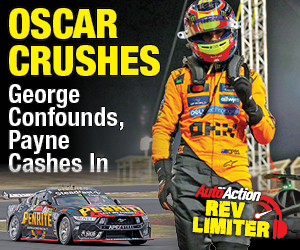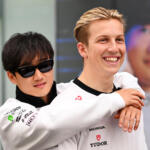The Red Bull Abattoirs

By Andrew Clarke
Date posted: 1 April 2025
Red Bull Racing’s approach to driver management has been marked by swift and sometimes controversial decisions, leading to several high-profile dismissals. The recent replacement of Liam Lawson after just two races in the 2025 season underscores this ongoing trend.
Red Bull Racing entered Formula 1 in 2005 after buying Jaguar’s F1 team; it retained David Coulthard as its lead driver and Christian Klien as one of its second drivers. From there, we have this memory that it sacks second drivers at the drop of a hat, but the reality is slightly different.
Slightly!
The reality might be that RBR is treated as a one-car team, and the second driver is just there because the team must enter two cars. That leaves the second driver fully exposed.
There is sometimes brutality regarding its driver line-up, and RBR Advisor Helmut Marko’s frank honesty – delivered with a lack of tact and humanity – often forces team principal Christian Horner into recovery mode. In 20 years, it has only sacked eight drivers during a season, although recency bias shows one in each of the past three seasons.
Seven sackings in 20 seasons don’t sound like much, but few teams replace drivers mid-season, hence the executioner reputation for the teams. Hanging on to Sergio Perez was an outlier, on performances alone, under the ‘brutality precedent’, he should have been sacking well before he was.
Even the second team—Scuderia Toro Rosso into Scuderia Alpha Tauri into Racing Bulls—has had more stability than we remember, with the axe generally swinging at the end of a season. Four times it has sacked a driver during the season.

Pierre Gasly will return to Toro Rosso – Photo: Red Bull
The In-Season Sacking Time Line
Most of the drivers sacked by Red Bull Racing disappeared from Formula 1. A couple have hung around the edges, but only Pierre Gasly and Alex Albon have revived their careers.
The first sacking came in the second season of Red Bull Racing. In 2006, Christian Klien was replaced mid-season due to underwhelming results, being replaced by Robert Doornbos, who was effectively sacked at the season’s end. The following year, American driver Scott Speed faced a similar fate in the junior team after a series of disappointing finishes. He was replaced by Sebastian Vettel, who was eventually promoted to the main team and won four titles in a row.
It took until 2016 for another mid-season axing, with Daniil Kvyat getting dumped for Max Verstappen in the main team a year and a bit after moving up to RBR in 2015 (he ran the junior team in 2014), giving it space to blood Verstappen. Kvyat would spend the next few years as a temporary fix each time Marko tired of a driver, twice returning to the junior team.
Pierre Gasly’s trajectory within the Red Bull ecosystem exemplifies the team’s high expectations. After a strong debut with Toro Rosso in 2017, Gasly was promoted to Red Bull Racing in 2019.
However, his tenure was short-lived; after just 12 races, he was demoted back to Toro Rosso due to inconsistent performances. On his return to the junior team, he secured his first Formula 1 podium with a second-place finish at the 2019 Brazilian Grand Prix. He won remarkably at the 2020 Italian Grand Prix in Monza, marking AlphaTauri’s first and most recent win under its new name and only its second since inception.
In 2023, Gasly left to join Alpine, partnering with fellow Frenchman Esteban Ocon. His inaugural season with Alpine was highlighted by a podium finish at the Dutch Grand Prix, where he secured third place. The following year, despite a challenging start, Gasly played a pivotal role in Alpine’s double podium finish at the Brazilian Grand Prix, finishing third behind his teammate Ocon, and now he is deeply entrenched at Alpine, albeit with Franco Colapinto knocking on the door with a big bag of money.
Alexander Albon’s journey mirrors the challenges many face within the Red Bull program. Debuting with Toro Rosso in 2019, Albon was swiftly promoted to Red Bull Racing mid-season, replacing Gasly.
Despite showing promise, he struggled to match teammate Max Verstappen’s performance. The team was entirely focused on Verstappen, building a car for the Dutchman from which few others have been able to extract speed consistently. It’s not a bad strategy with four titles, but it’s not great for the number two driver.
In 2021, Albon was replaced by Sergio Pérez and took on a test and reserve driver role while competing in the Deutsche Tourenwagen Masters (DTM). There, he secured a maiden win at the Nürburgring before returning to Formula 1 in 2022 with Williams.
He quickly established himself in the team as a fast qualifier and mature racer. He proved he could, and can, drive.
His performances in 2024 contributed significantly to Williams’ midfield battles, and he secured a multi-year contract extension. This solidified his place in the team with the arrival of Carlos Sainz Jr., whom he is already outpacing in 2025.
Sergio Pérez joined Red Bull Racing in 2021 and initially showed promise with multiple podium finishes. In 2023, he struggled as the car pivoted even further to something only Max Verstappen could drive and then the 2024 season proved especially challenging for the Mexican driver.
Despite a strong start with consecutive second-place finishes, Pérez’s performance declined, culminating in incidents and retirements. He finished the season eighth in the standings, significantly trailing teammate Max Verstappen, who clinched his fourth World Drivers’ Championship.
This performance disparity led to a mutual agreement – aka, sacking – for Pérez to depart the team after the 2024 season.
In December 2024, Red Bull announced that New Zealand driver Liam Lawson would replace Pérez for the 2025 season, partnering with Verstappen.
Lawson, who had previously driven for Red Bull’s sister team, Racing Bulls, was seen as a promising talent within the Red Bull Junior Team.
However, his tenure with Red Bull Racing was short-lived… the shortest of all, in fact. In the season opener at the Australian Grand Prix, Lawson qualified 18th and retired from the race after a crash. The subsequent Chinese Grand Prix saw him qualify last and finish 15th, failing to secure any points.
He was sacked last week and shuffled back to the junior team, with Yuki Tsunoda brought in as the next bull to the slaughter.

Red Bull Racing turned Alex Albon’s career on its head when it sacked him.
Red Bull Racing
| Year |
Lead Driver |
2nd Driver |
3rd Driver |
| 2005 |
David Coulthard |
Christian Klien/Vitantonio Liuzzi* |
|
| 2006 |
David Coulthard |
Christian Klien# |
Robert Doornbos |
| 2007 |
David Coulthard |
Mark Webber |
|
| 2008 |
David Coulthard |
Mark Webber |
|
| 2009 |
Mark Webber |
Sebastian Vettel |
|
| 2010 |
Sebastian Vettel |
Mark Webber |
|
| 2011 |
Sebastian Vettel |
Mark Webber |
|
| 2012 |
Sebastian Vettel |
Mark Webber |
|
| 2013 |
Sebastian Vettel |
Mark Webber |
|
| 2014 |
Sebastian Vettel |
Daniel Ricciardo |
|
| 2015 |
Daniel Ricciardo |
Daniil Kvyat |
|
| 2016 |
Daniel Ricciardo |
Daniil Kvyat# |
Max Verstappen |
| 2017 |
Max Verstappen |
Daniel Ricciardo |
|
| 2018 |
Max Verstappen |
Daniel Ricciardo |
|
| 2019 |
Max Verstappen |
Pierre Gasly# |
Alex Albon |
| 2020 |
Max Verstappen |
Alex Albon# |
|
| 2021 |
Max Verstappen |
Sergio Pérez |
|
| 2022 |
Max Verstappen |
Sergio Pérez |
|
| 2023 |
Max Verstappen |
Sergio Pérez |
|
| 2024 |
Max Verstappen |
Sergio Pérez# |
|
| 2025 |
Max Verstappen |
Liam Lawson # |
Yuki Tsunoda |
* Klien and Liuzzi were contracted to share the second car in RBR’s first season
# Sacked
The Second Team
| Year |
Lead Driver |
2nd Driver |
3rd Driver |
| 2006 |
Vitantonio Liuzzi |
Scott Speed |
|
| 2007 |
Vitantonio Liuzzi |
Scott Speed# |
Sebastian Vettel |
| 2008 |
Sébastien Bourdais |
Sebastian Vettel^ |
|
| 2009 |
Sébastien Buemi |
Sébastien Bourdais# |
Jaime Alguersuari |
| 2010 |
Sébastien Buemi |
Jaime Alguersuari |
|
| 2011 |
Sébastien Buemi# |
Jaime Alguersuari# |
|
| 2012 |
Daniel Ricciardo |
Jean-Éric Vergne |
|
| 2013 |
Daniel Ricciardo^ |
Jean-Éric Vergne |
|
| 2014 |
Jean-Éric Vergne# |
Daniil Kvyat# |
|
| 2015 |
Max Verstappen |
Carlos Sainz Jr. |
|
| 2016 |
Max Verstappen^/ Daniil Kvyat |
Carlos Sainz Jr |
|
| 2017 |
Carlos Sainz Jr |
Daniil Kvyat# |
Pierre Gasly/Brendon Hartley+ |
| 2018 |
Pierre Gasly^ |
Brendon Hartley |
|
| 2019 |
Alexander Albon^/ Pierre Gasly |
Daniil Kvyat |
|
| 2020 |
Pierre Gasly |
Daniil Kvyat# |
|
| 2021 |
Pierre Gasly |
Yuki Tsunoda |
|
| 2022 |
Pierre Gasly |
Yuki Tsunoda |
|
| 2023 |
Yuki Tsunoda |
Nick de Vries# |
Daniel Ricciardo/Liam Lawson |
| 2024 |
Yuki Tsunoda |
Daniel Ricciardo# |
Liam Lawson^ |
| 2023 |
Yuki Tsunoda^/Liam Lawson |
Isaac Hadjar |
|
# Sacked
^ Promoted to RBR
+ One race when Gasly was unavailable
In Season Sackings
2006 Christian Klien – 14 points from 52 Grand Prix. He has since raced in V8 Supercars, F3000, Sportscars, DTM, GT3 and TCR after time as an F1 test driver but never drove a GP again.
2007 Scott Speed (Junior Team) – 0 points from 28 Grand Prix. He has raced since in A1 Grand Prix, NASCAR, IndyCar, Formula E and Rallycross. He never looked back at F1 after leaving.
2016 Daniil Kvyat – 202 points from 112 Grand Prix. He has since run in Sportscars, NASCAR and Formula E. Oddly, after making way for Verstappen at Red Bull Racing, he can also lay claim to dating Kelly Piquet (with whom he has a child) before Verstappen.
2017 Daniil Kvyat (Junior Team)
2019 Pierre Gasly – 436 Points, one win, five podiums from 156 Grand Prix. After getting dumped from the main team, Gasly revived his career with a successful time in the junior team. He is still racing with Alpine in F1.
2023 Nyck de Vries (Junior Team): 2 points from 11 Grand Prix. He moved into Formula E with Mahindra Racing, where he still races.
2024 Daniel Ricciardo (Junior Team) – 1329 points, eight wins, 31 podiums from 258 Grand Prix. Ricciardo was an early star for Red Bull before leaving, with the team focusing only on Verstappen. He eventually returned to the junior team and was sacked last season. He has retired.
2025 Liam Lawson – 6 points from 13 Grand Prix. Lawson was elevated to the main team after replacing Ricciardo at Racing Bulls in 2024. He lasted two races only and has been dropped back to the junior team.
Recent Stories
array (
0 =>
WP_Term::__set_state(array(
'term_id' => 37,
'name' => 'F1',
'slug' => 'f1',
'term_group' => 0,
'term_taxonomy_id' => 37,
'taxonomy' => 'category',
'description' => 'An Introduction to Formula One (F1)
Formula One, or F1, is the highest class of single-seater auto racing, governed by the Fédération Internationale de l\'Automobile (FIA) and is owned by Liberty Media. The name "Formula One" refers to the set of rules or formula that all cars and drivers must comply with.
The F1 season consists of a series of races, known as Grands Prix, held on purpose-built circuits or public roads around the world. The results of each race are combined to determine two annual championships: one for drivers and one for constructors (teams).
The history of Formula One can be traced back to the pre-war Grand Prix racing, which featured open-wheel cars with supercharged engines. The first World Championship of Drivers was organised by the FIA in 1950, following the end of World War II. The first race was held at Silverstone, England, and was won by Giuseppe Farina, driving an Alfa Romeo. The first constructors\' championship was introduced in 1958 and was won by Vanwall.
Formula One has seen many changes and innovations over the years, both in terms of technology and regulations. Some of the most notable developments include the introduction of rear-engined cars in the late 1950s, the use of aerodynamic wings in the late 1960s, the adoption of turbocharged engines in the late 1970s, the emergence of electronic driver aids in the late 1980s, the switch to V10 and then V8 engines in the 1990s and 2000s, and the introduction of hybrid power units in 2014.
Formula One has also produced some of the greatest drivers and rivalries in the history of motorsport. Some of the most famous names include Juan Manuel Fangio, Jim Clark, Jackie Stewart, Niki Lauda, Ayrton Senna, Alain Prost, Michael Schumacher, Lewis Hamilton, and Sebastian Vettel. Some of the most intense battles for the championship have been between Fangio and Stirling Moss in the 1950s, Lauda and James Hunt in the 1970s, Senna and Prost in the late 1980s, Schumacher and Mika Hakkinen in the late 1990s, and Hamilton and Vettel in the 2010s.
Formula One is widely regarded as the pinnacle of motorsport, attracting millions of fans and viewers worldwide. The sport is also a huge business, involving billions of dollars in revenue and expenditure. The teams compete for prize money, sponsorship deals, and media rights, while the drivers earn millions of dollars in salaries and endorsements. The sport is also influenced by politics, regulations, and controversies, such as doping scandals, espionage cases, safety issues, and environmental concerns.
The following is a list of all F1 World Drivers Champions by year, from 1950 to 2020:
1950-1959
1950: Giuseppe Farina (Italy) - Alfa Romeo 158, Alfa Romeo
1951: Juan Manuel Fangio (Argentina) - Alfa Romeo 159, Alfa Romeo
1952: Alberto Ascari (Italy) - Ferrari 500, Ferrari
1953: Alberto Ascari (Italy) - Ferrari 500, Ferrari
1954: Juan Manuel Fangio (Argentina) - Maserati 250F, Maserati / Mercedes-Benz W196, Mercedes-Benz
1955: Juan Manuel Fangio (Argentina) - Mercedes-Benz W196, Mercedes-Benz
1956: Juan Manuel Fangio (Argentina) - Ferrari D50, Ferrari
1957: Juan Manuel Fangio (Argentina) - Maserati 250F, Maserati
1958: Mike Hawthorn (United Kingdom) - Ferrari 246, Ferrari
1959: Jack Brabham (Australia) - Cooper T51, Cooper-Climax
1960-1969
1960: Jack Brabham (Australia) - Cooper T53, Cooper-Climax
1961: Phil Hill (United States) - Ferrari 156, Ferrari
1962: Graham Hill (United Kingdom) - BRM P57, BRM
1963: Jim Clark (United Kingdom) - Lotus 25, Lotus-Climax
1964: John Surtees (United Kingdom) - Ferrari 158, Ferrari
1965: Jim Clark (United Kingdom) - Lotus 33, Lotus-Climax
1966: Jack Brabham (Australia) - Brabham BT19, Brabham-Repco
1967: Denny Hulme (New Zealand) - Brabham BT20, Brabham-Repco
1968: Graham Hill (United Kingdom) - Lotus 49, Lotus-Ford
1969: Jackie Stewart (United Kingdom) - Matra MS80, Matra-Ford
1970-1979
1970: Jochen Rindt (Austria) - Lotus 72, Lotus-Ford
1971: Jackie Stewart (United Kingdom) - Tyrrell 003, Tyrrell-Ford
1972: Emerson Fittipaldi (Brazil) - Lotus 72D, Lotus-Ford
1973: Jackie Stewart (United Kingdom) - Tyrrell 006, Tyrrell-Ford
1974: Emerson Fittipaldi (Brazil) - McLaren M23, McLaren-Ford
1975: Niki Lauda (Austria) - Ferrari 312T, Ferrari
1976: James Hunt (United Kingdom) - McLaren M23, McLaren-Ford
1977: Niki Lauda (Austria) - Ferrari 312T2, Ferrari
1978: Mario Andretti (United States) - Lotus 79, Lotus-Ford
1979: Jody Scheckter (South Africa) - Ferrari 312T4, Ferrari
1980-1989
1980: Alan Jones (Australia) - Williams FW07B, Williams-Ford
1981: Nelson Piquet (Brazil) - Brabham BT49C, Brabham-Ford
1982: Keke Rosberg (Finland) - Williams FW08, Williams-Ford
1983: Nelson Piquet (Brazil) - Brabham BT52, Brabham-BMW
1984: Niki Lauda (Austria) - McLaren MP4/2, McLaren-TAG
1985: Alain Prost (France) - McLaren MP4/2B, McLaren-TAG
1986: Alain Prost (France) - McLaren MP4/2C, McLaren-TAG
1987: Nelson Piquet (Brazil) - Williams FW11B, Williams-Honda
1988: Ayrton Senna (Brazil) - McLaren MP4/4, McLaren-Honda
1989: Alain Prost (France) - McLaren MP4/5, McLaren-Honda
1990-1999
1990: Ayrton Senna (Brazil) - McLaren MP4/5B, McLaren-Honda
1991: Ayrton Senna (Brazil) - McLaren MP4/6, McLaren-Honda
1992: Nigel Mansell (United Kingdom) - Williams FW14B, Williams-Renault
1993: Alain Prost (France) - Williams FW15C, Williams-Renault
1994: Michael Schumacher (Germany) - Benetton B194, Benetton-Ford
1995: Michael Schumacher (Germany) - Benetton B195, Benetton-Renault
1996: Damon Hill (United Kingdom) - Williams FW18, Williams-Renault
1997: Jacques Villeneuve (Canada) - Williams FW19, Williams-Renault
1998: Mika Häkkinen (Finland) - McLaren MP4/13, McLaren-Mercedes
1999: Mika Häkkinen (Finland) - McLaren MP4/14, McLaren-Mercedes
2000-2009
2000: Michael Schumacher (Germany) - Ferrari F1-2000, Ferrari
2001: Michael Schumacher (Germany) - Ferrari F2001, Ferrari
2002: Michael Schumacher (Germany) - Ferrari F2002, Ferrari
2003: Michael Schumacher (Germany) - Ferrari F2003-GA, Ferrari
2004: Michael Schumacher (Germany) - Ferrari F2004, Ferrari
2005: Fernando Alonso (Spain) - Renault R25, Renault
2006: Fernando Alonso (Spain) - Renault R26, Renault
2007: Kimi Räikkönen (Finland) - Ferrari F2007, Ferrari
2008: Lewis Hamilton (United Kingdom) - McLaren MP4-23, McLaren-Mercedes
2009: Jenson Button (United Kingdom) - Brawn BGP 001, Brawn-Mercedes
2010-2020
2010: Sebastian Vettel (Germany) - Red Bull RB6, Red Bull-Renault
2011: Sebastian Vettel (Germany) - Red Bull RB7, Red Bull-Renault
2012: Sebastian Vettel (Germany) - Red Bull RB8, Red Bull-Renault
2013: Sebastian Vettel (Germany) - Red Bull RB9, Red Bull-Renault
2014: Lewis Hamilton (United Kingdom) - Mercedes F1 W05 Hybrid, Mercedes
2015: Lewis Hamilton (United Kingdom) - Mercedes F1 W06 Hybrid, Mercedes
2016: Nico Rosberg (Germany) - Mercedes F1 W07 Hybrid, Mercedes
2017: Lewis Hamilton (United Kingdom) - Mercedes F1 W08 EQ Power+, Mercedes
2018: Lewis Hamilton (United Kingdom) - Mercedes F1 W09 EQ Power+, Mercedes
2019: Lewis Hamilton (United Kingdom) - Mercedes F1 W10 EQ Power+, Mercedes
2020: Lewis Hamilton (United Kingdom) - Mercedes F1 W11 EQ Power+, Mercedes
2021-
2021: Max Verstappen (Netherlands) – Red Bull RB16B, Honda
2022: Max Verstappen (Netherlands) – Red Bull RB18, Red Bull Power Trains Honda
2023: Max Verstappen (Netherlands) – Red Bull RB19, Red Bull Power Trains Honda
2024: Max Verstappen (Netherlands) – Red Bull RB20, Red Bull Power Trains Honda',
'parent' => 660,
'count' => 2621,
'filter' => 'raw',
'cat_ID' => 37,
'category_count' => 2621,
'category_description' => 'An Introduction to Formula One (F1)
Formula One, or F1, is the highest class of single-seater auto racing, governed by the Fédération Internationale de l\'Automobile (FIA) and is owned by Liberty Media. The name "Formula One" refers to the set of rules or formula that all cars and drivers must comply with.
The F1 season consists of a series of races, known as Grands Prix, held on purpose-built circuits or public roads around the world. The results of each race are combined to determine two annual championships: one for drivers and one for constructors (teams).
The history of Formula One can be traced back to the pre-war Grand Prix racing, which featured open-wheel cars with supercharged engines. The first World Championship of Drivers was organised by the FIA in 1950, following the end of World War II. The first race was held at Silverstone, England, and was won by Giuseppe Farina, driving an Alfa Romeo. The first constructors\' championship was introduced in 1958 and was won by Vanwall.
Formula One has seen many changes and innovations over the years, both in terms of technology and regulations. Some of the most notable developments include the introduction of rear-engined cars in the late 1950s, the use of aerodynamic wings in the late 1960s, the adoption of turbocharged engines in the late 1970s, the emergence of electronic driver aids in the late 1980s, the switch to V10 and then V8 engines in the 1990s and 2000s, and the introduction of hybrid power units in 2014.
Formula One has also produced some of the greatest drivers and rivalries in the history of motorsport. Some of the most famous names include Juan Manuel Fangio, Jim Clark, Jackie Stewart, Niki Lauda, Ayrton Senna, Alain Prost, Michael Schumacher, Lewis Hamilton, and Sebastian Vettel. Some of the most intense battles for the championship have been between Fangio and Stirling Moss in the 1950s, Lauda and James Hunt in the 1970s, Senna and Prost in the late 1980s, Schumacher and Mika Hakkinen in the late 1990s, and Hamilton and Vettel in the 2010s.
Formula One is widely regarded as the pinnacle of motorsport, attracting millions of fans and viewers worldwide. The sport is also a huge business, involving billions of dollars in revenue and expenditure. The teams compete for prize money, sponsorship deals, and media rights, while the drivers earn millions of dollars in salaries and endorsements. The sport is also influenced by politics, regulations, and controversies, such as doping scandals, espionage cases, safety issues, and environmental concerns.
The following is a list of all F1 World Drivers Champions by year, from 1950 to 2020:
1950-1959
1950: Giuseppe Farina (Italy) - Alfa Romeo 158, Alfa Romeo
1951: Juan Manuel Fangio (Argentina) - Alfa Romeo 159, Alfa Romeo
1952: Alberto Ascari (Italy) - Ferrari 500, Ferrari
1953: Alberto Ascari (Italy) - Ferrari 500, Ferrari
1954: Juan Manuel Fangio (Argentina) - Maserati 250F, Maserati / Mercedes-Benz W196, Mercedes-Benz
1955: Juan Manuel Fangio (Argentina) - Mercedes-Benz W196, Mercedes-Benz
1956: Juan Manuel Fangio (Argentina) - Ferrari D50, Ferrari
1957: Juan Manuel Fangio (Argentina) - Maserati 250F, Maserati
1958: Mike Hawthorn (United Kingdom) - Ferrari 246, Ferrari
1959: Jack Brabham (Australia) - Cooper T51, Cooper-Climax
1960-1969
1960: Jack Brabham (Australia) - Cooper T53, Cooper-Climax
1961: Phil Hill (United States) - Ferrari 156, Ferrari
1962: Graham Hill (United Kingdom) - BRM P57, BRM
1963: Jim Clark (United Kingdom) - Lotus 25, Lotus-Climax
1964: John Surtees (United Kingdom) - Ferrari 158, Ferrari
1965: Jim Clark (United Kingdom) - Lotus 33, Lotus-Climax
1966: Jack Brabham (Australia) - Brabham BT19, Brabham-Repco
1967: Denny Hulme (New Zealand) - Brabham BT20, Brabham-Repco
1968: Graham Hill (United Kingdom) - Lotus 49, Lotus-Ford
1969: Jackie Stewart (United Kingdom) - Matra MS80, Matra-Ford
1970-1979
1970: Jochen Rindt (Austria) - Lotus 72, Lotus-Ford
1971: Jackie Stewart (United Kingdom) - Tyrrell 003, Tyrrell-Ford
1972: Emerson Fittipaldi (Brazil) - Lotus 72D, Lotus-Ford
1973: Jackie Stewart (United Kingdom) - Tyrrell 006, Tyrrell-Ford
1974: Emerson Fittipaldi (Brazil) - McLaren M23, McLaren-Ford
1975: Niki Lauda (Austria) - Ferrari 312T, Ferrari
1976: James Hunt (United Kingdom) - McLaren M23, McLaren-Ford
1977: Niki Lauda (Austria) - Ferrari 312T2, Ferrari
1978: Mario Andretti (United States) - Lotus 79, Lotus-Ford
1979: Jody Scheckter (South Africa) - Ferrari 312T4, Ferrari
1980-1989
1980: Alan Jones (Australia) - Williams FW07B, Williams-Ford
1981: Nelson Piquet (Brazil) - Brabham BT49C, Brabham-Ford
1982: Keke Rosberg (Finland) - Williams FW08, Williams-Ford
1983: Nelson Piquet (Brazil) - Brabham BT52, Brabham-BMW
1984: Niki Lauda (Austria) - McLaren MP4/2, McLaren-TAG
1985: Alain Prost (France) - McLaren MP4/2B, McLaren-TAG
1986: Alain Prost (France) - McLaren MP4/2C, McLaren-TAG
1987: Nelson Piquet (Brazil) - Williams FW11B, Williams-Honda
1988: Ayrton Senna (Brazil) - McLaren MP4/4, McLaren-Honda
1989: Alain Prost (France) - McLaren MP4/5, McLaren-Honda
1990-1999
1990: Ayrton Senna (Brazil) - McLaren MP4/5B, McLaren-Honda
1991: Ayrton Senna (Brazil) - McLaren MP4/6, McLaren-Honda
1992: Nigel Mansell (United Kingdom) - Williams FW14B, Williams-Renault
1993: Alain Prost (France) - Williams FW15C, Williams-Renault
1994: Michael Schumacher (Germany) - Benetton B194, Benetton-Ford
1995: Michael Schumacher (Germany) - Benetton B195, Benetton-Renault
1996: Damon Hill (United Kingdom) - Williams FW18, Williams-Renault
1997: Jacques Villeneuve (Canada) - Williams FW19, Williams-Renault
1998: Mika Häkkinen (Finland) - McLaren MP4/13, McLaren-Mercedes
1999: Mika Häkkinen (Finland) - McLaren MP4/14, McLaren-Mercedes
2000-2009
2000: Michael Schumacher (Germany) - Ferrari F1-2000, Ferrari
2001: Michael Schumacher (Germany) - Ferrari F2001, Ferrari
2002: Michael Schumacher (Germany) - Ferrari F2002, Ferrari
2003: Michael Schumacher (Germany) - Ferrari F2003-GA, Ferrari
2004: Michael Schumacher (Germany) - Ferrari F2004, Ferrari
2005: Fernando Alonso (Spain) - Renault R25, Renault
2006: Fernando Alonso (Spain) - Renault R26, Renault
2007: Kimi Räikkönen (Finland) - Ferrari F2007, Ferrari
2008: Lewis Hamilton (United Kingdom) - McLaren MP4-23, McLaren-Mercedes
2009: Jenson Button (United Kingdom) - Brawn BGP 001, Brawn-Mercedes
2010-2020
2010: Sebastian Vettel (Germany) - Red Bull RB6, Red Bull-Renault
2011: Sebastian Vettel (Germany) - Red Bull RB7, Red Bull-Renault
2012: Sebastian Vettel (Germany) - Red Bull RB8, Red Bull-Renault
2013: Sebastian Vettel (Germany) - Red Bull RB9, Red Bull-Renault
2014: Lewis Hamilton (United Kingdom) - Mercedes F1 W05 Hybrid, Mercedes
2015: Lewis Hamilton (United Kingdom) - Mercedes F1 W06 Hybrid, Mercedes
2016: Nico Rosberg (Germany) - Mercedes F1 W07 Hybrid, Mercedes
2017: Lewis Hamilton (United Kingdom) - Mercedes F1 W08 EQ Power+, Mercedes
2018: Lewis Hamilton (United Kingdom) - Mercedes F1 W09 EQ Power+, Mercedes
2019: Lewis Hamilton (United Kingdom) - Mercedes F1 W10 EQ Power+, Mercedes
2020: Lewis Hamilton (United Kingdom) - Mercedes F1 W11 EQ Power+, Mercedes
2021-
2021: Max Verstappen (Netherlands) – Red Bull RB16B, Honda
2022: Max Verstappen (Netherlands) – Red Bull RB18, Red Bull Power Trains Honda
2023: Max Verstappen (Netherlands) – Red Bull RB19, Red Bull Power Trains Honda
2024: Max Verstappen (Netherlands) – Red Bull RB20, Red Bull Power Trains Honda',
'cat_name' => 'F1',
'category_nicename' => 'f1',
'category_parent' => 660,
)),
1 =>
WP_Term::__set_state(array(
'term_id' => 2029,
'name' => 'ZZZ-Email',
'slug' => 'email',
'term_group' => 0,
'term_taxonomy_id' => 2029,
'taxonomy' => 'category',
'description' => '',
'parent' => 2031,
'count' => 6413,
'filter' => 'raw',
'cat_ID' => 2029,
'category_count' => 6413,
'category_description' => '',
'cat_name' => 'ZZZ-Email',
'category_nicename' => 'email',
'category_parent' => 2031,
)),
2 =>
WP_Term::__set_state(array(
'term_id' => 2031,
'name' => 'ZZZ-RSSFeeds',
'slug' => 'zzz-rssfeeds',
'term_group' => 0,
'term_taxonomy_id' => 2031,
'taxonomy' => 'category',
'description' => '',
'parent' => 0,
'count' => 5767,
'filter' => 'raw',
'cat_ID' => 2031,
'category_count' => 5767,
'category_description' => '',
'cat_name' => 'ZZZ-RSSFeeds',
'category_nicename' => 'zzz-rssfeeds',
'category_parent' => 0,
)),
)




